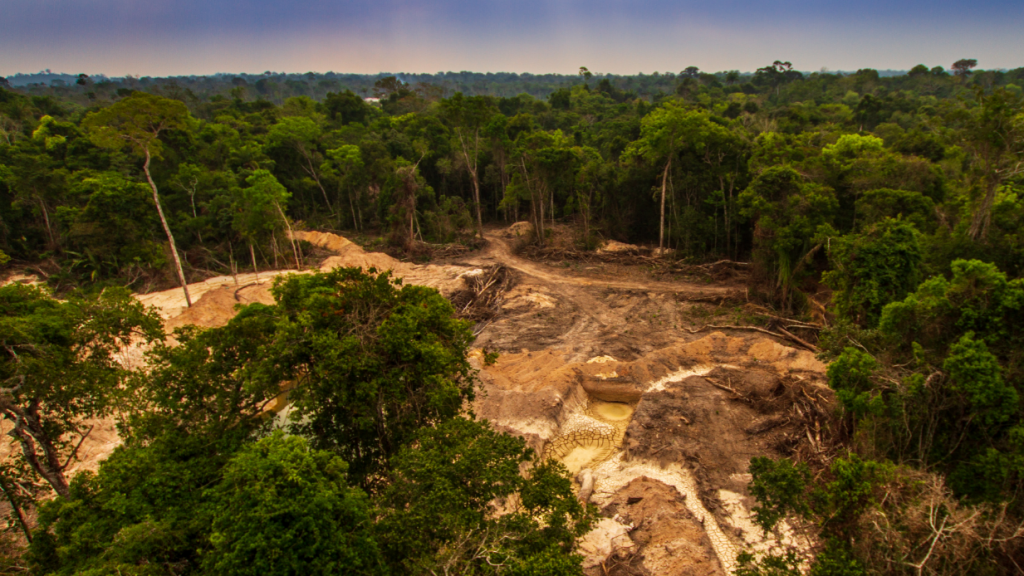
Mining operations in the Amazon basin now cover more than 20% of Indigenous lands, according to a new report from World Resources Institute (WRI) and the Amazon Geo-Referenced Socio-Environmental Information Network (RAISG).
According to the research, large-scale mining concessions and illegal mining on Indigenous territories threaten hundreds of Indigenous communities and endanger critical ecosystems across 450,000 square kilometers.

WRI estimates that 1,131 Indigenous lands across the Amazon basin suffer from the impacts of legal and/or illegal mining. According to the report, illegal miners have invaded 370 Indigenous lands, including many in Brazil, where all mining on Indigenous lands is not regulated. Illegal mining operations are also leaching toxic chemicals, such as mercury, into at least 30 Amazonian rivers, says WRI.
Research identified four sets of rights critical for indigenous peoples to secure and protect their lands: land rights; mineral rights; the right of free, prior, and informed consent; and the right of first refusal
World Resources Institute
“Despite growing evidence that Indigenous peoples are among the world’s greatest environmental stewards, our paper confirms what Amazonian Indigenous leaders have been telling us for years,” says co-author and Director, Land and Resource Rights Initiative at WRI, Peter Veit.
“Across the Amazon, Indigenous territories are under siege from mining, both legal and illegal, and these activities are eroding communities’ ability to protect themselves, prevent deforestation and safeguard ecosystems that are essential to the planet’s wellbeing,” Veit says.
Past WRI research found deforestation rates are two to three times lower within tenure-secure Indigenous lands than outside those territories.
WRI says that mining is eroding communities’ proven ability to prevent deforestation. From 2000 to 2015, Indigenous lands with mining activities had higher incidences of tree cover loss than those without mining across the Amazon, according to the research.
“In Bolivia, Ecuador and Peru, forest loss was at least three times higher in Indigenous territories with mining operations – both legal and illegal – than those without; and one to two times higher in Colombia and Venezuela,” WRI notes in a press release.

“We found that countries in the Amazon all grant some important legal protections to Indigenous People, but these protections are often weakly or unevenly enforced,” says co-author and International Legal Consultant Patricia Quijano Vallejos.
“Governments either own the mineral resources or control them, so Indigenous Peoples can neither prohibit miners with government permits from entering their lands nor fully access the minerals within their territories.”
In their legal analysis of six Amazonian countries that hold over 90% of the Amazon basin, including Bolivia, Brazil, Colombia, Ecuador, Guyana and Peru, the authors note that national laws and regulations often favor companies over Indigenous peoples.
Weak government oversight of mining activities can also lead to violent conflicts between Indigenous communities and miners. Global Witness reported a record 212 land and environmental defenders were murdered in 2019. Over two-thirds of these killings occurred in Latin America.

Even in countries like Guyana, the only nation reviewed in WRI’s research that grants Amerindian Peoples a limited right of consent to any mining development on their lands, authorities ‘have ways around legislation’.
“The reality on the ground is quite different,” says Michael McGarrell, who represents the Amerindian People’s Association in Guyana.
“Government officials can say, for example, that a mining concession on Amerindian land is in the public interest. This means that even if a community says no, the minister can say yes,” McGarrell notes.
Protecting Indigenous communities would require a radical shift in governments’ approach to mining, says Eleodoro Mayorga Alba, former minister of mines for Peru, where significant progress has already been made in adopting legislation to protect Indigenous communities and their lands.
“This includes establishing and enforcing social and environmental safeguards aligned with international standards, more consistently monitoring mining operations across Indigenous lands and stepping up efforts to identify and prosecute those who facilitate illegal mining practices.”
The report also finds that in several countries, Indigenous communities have successfully used their rights to shut down illegal, harmful mining on their lands.
“But to secure long-term benefits, Indigenous communities will need financial and technical assistance to monitor illegal mining practices on their lands,” says WRI.
The research identified four sets of rights critical for indigenous peoples to secure and protect their lands: land rights; mineral rights; the right of
free, prior, and informed consent; and the right of first refusal.
“Governments should reform laws to recognize more rights for indigenous peoples over the minerals on their lands whether the lands are formalized or held under customary tenure arrangements. Doing so would give them a voice in decisions regarding mineral developments on their lands. It would also help ensure they receive a fair share of resulting benefits.”
2 Comments
Michael Doyle
“Mining operations in the Amazon basin now cover more than 20% of Indigenous lands”
Dont you check articles for common sense?
Mining operations (legal or illegal) dont cover anything like 20%, that is 143,000km2, I doubt there is that much area covered by mining operations in the entire world. It is exploration permits, not mining operations.
ricardo
A lot of Indigenous people want the mining, and in fact do it themselves. Need to include that part in the article also please.